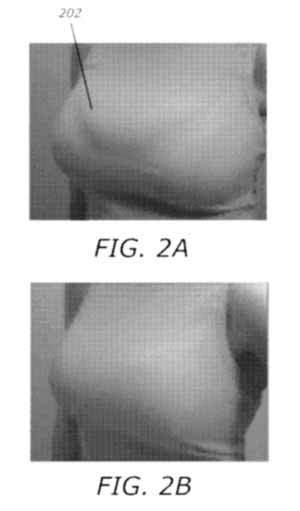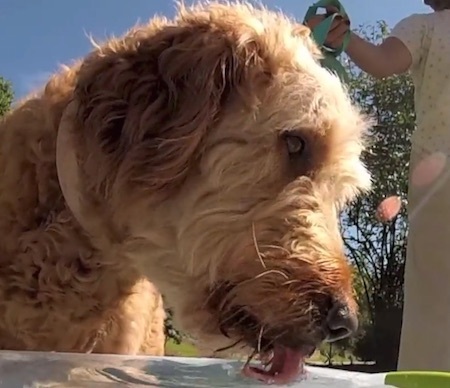Marc Abrahams's Blog, page 361
November 25, 2014
Dog lapping in the matrix
A fluid dynamics approach to gaining understanding (adding to what’s known) of the way liquids are reliably transferred into the mouths of dogs and cats:
“Dog lapping in the matrix,” presented at the 67th Annual Meeting of the APS Division of Fluid Dynamics (November 23, 2014 — November 25, 2014), by Sean Gart (Virginia Tech) Jake Socha (Virginia Tech) Pavlos Vlachos (Purdue University), and Sunghwan Jung (Virginia Tech):
“Animals with incomplete cheeks (i.e. dogs and cats) need to move fluid against gravity into the body by means other than suction. They do this by lapping fluid with their tongue. When a dog drinks, it curls its tongue posteriorly while plunging it into the fluid and then quickly withdraws its tongue back into the mouth. During this fast retraction fluid sticks to the ventral part of the curled tongue and is drawn into the mouth due to inertia. We show examples of this drinking behavior and try to understand the relationship between tongue dynamics and geometry, lapping frequency, and dog weight. We also compare the results with a physical experiment of a rounded rod impact and withdrawal from a liquid bath.”
The researchers created a demonstrative video:
Rhodi Lee gives some additional details, in Tech Times.
(Thanks to Kerri Wachter for bringing this to our attention.)
BONUS: The 2014 Ig Nobel Prize for biology honored an ongoing attempt to determine the alignment of liquids as they transfer out the other end of dogs’ digestive systems.

“Facts are stupid things,” he would say, “until…”
Richard Conniff writes, in the Strange Behaviors blog:
Look, Look, Look! A Lesson in the Art of SeeingI’ve never been particularly fond of the nineteenth century naturalist Louis Agassiz, probably due to a time I was sitting in a library at Harvard and holding in my hands a letter he had written to his mother about his feelings on first seeing an African-American. It was so appallingly racist, so naive, so entitled to an unwarranted sense of superiority that I actually gasped out loud.
But just now, I was looking over a book called Louis Agassiz as a Teacher, and I read this brilliant and almost endearing account of his methods. Entirely beyond natural history, it is a very fine lesson in the art of seeing, and belongs in a category I should probably call “Valuable Lessons from Loathesome Men.” It was written in 1874 by Samuel H. Scudder, a young entomologist who found himself being instructed, not altogether happily, by Agassiz, a very learned student of fish:
——-
It was more than fifteen years ago that I entered the laboratory of Professor Agassiz, and told him I had enrolled my name in the Scientific School as a student of natural history. He asked me a few questions about my object in coming, my antecedents generally, the mode in which I afterwards proposed to use the knowledge I might acquire, and, finally, whether I wished to study any special branch. To the latter I replied that, while I wished to be well grounded in all departments of zoology, I purposed to devote myself specially to insects.
‘When do you wish to begin?’ he asked.
‘Now,’ I replied.
This seemed to please him, and with an energetic ‘Very well!’ he reached from a shelf a huge jar of specimens in yellow alcohol.
‘Take this fish,’ said he, ‘and look at it; we call it a haemulon; by and by I will ask what you have seen…” [read the rest on the Strange Behaviors site.

November 24, 2014
Hot dogs (canines) with hops
 Dogs (Canis lupus familiaris) should if possible avoid hops (Humulus lupulus). For dogs ingesting hops can, and often do, overheat to an alarming, sometimes life-threatening degree. *see note. The physiological pathways involved are as yet poorly understood unknown. See: Toxicology Brief: Hops Make Dogs Hot, Veterinary Technician, August 2013 (Vol 34, No 8).
Dogs (Canis lupus familiaris) should if possible avoid hops (Humulus lupulus). For dogs ingesting hops can, and often do, overheat to an alarming, sometimes life-threatening degree. *see note. The physiological pathways involved are as yet poorly understood unknown. See: Toxicology Brief: Hops Make Dogs Hot, Veterinary Technician, August 2013 (Vol 34, No 8).
* Note:
Improbable has tried to find research regarding spontaneous combustion amongst canines, with very little, if any, success.
Photo credit: The picture, via Wikipedia, shows a healthy Whippet, a breed of Sighthound, which it seems are particularly susceptible.

November 23, 2014
mini-AIR November issue: Morphospace (and D’Arcy Thompson)
 The November issue of mini-AIR (our monthly e-mail newsletter just went out. (mini-AIR is a wee little supplement to the magazine). Topics include:
The November issue of mini-AIR (our monthly e-mail newsletter just went out. (mini-AIR is a wee little supplement to the magazine). Topics include:
D’Arcy Thompson in Empirical Morphospace
The Phytophagous Scarab Chafers Morphospace Limerick Competition
Pie’s Null Morphospace
and more
It also has info about upcoming events.
Mel [pictured here] says, “It’s swell.”
mini-AIR is the simplest way to keep informed about Improbable and Ig Nobel news and events.
Want to have mini-AIR e-mailed to you every month? Just add yourself to the mini-AIR list.
BONUS: Video of the D’Arcy Thompson Animal Parade, which began the 2011 Ig Nobel show (for National Science Week) at the University of Dundee. D’Arcy Thompson was based, for much of his spectacular scientific/literary career, at Dundee. These taxidermied critters, carried into the theatre by three Ig Nobel Prize winners, and by two of Dundee’s most illustrious modern scientists, and by one of Scotland’s most dynamic historians, are in the museum collection Thompson built at the university:
BONUS: Medusan morphospace

Chalk, Cheese, Wood: Berger
 Berger expresses an opinion as the the extent of metaphorical deterioration of Wood into chalk and cheese, in this small paper:
Berger expresses an opinion as the the extent of metaphorical deterioration of Wood into chalk and cheese, in this small paper:
“Chalk and Cheese: Response to Wood,” L.R. Berger, Journal of Human Evolution, vol. 43, no. 1, 2002, p. 126.

November 22, 2014
Grimes’s “20 nifty tricks to argue like a charlatan”
David Robert Grimes, in his blog Three Men and a Tiger, gives these 20 nifty tricks to argue like a charlatan”
When discussions arise, those with a vested interest are adept at sidetracking the debate with enough petty logical fallacies to fool an audience into thinking their claims have some merit…. Perhaps we should look at their techniques and admire the smoke and mirrors approach to discussion that can leave the most well informed earnest orator flummoxed and flustered. Let’s give these rogues their due, and identify some of their little tricks, in the hopes we can catch them out at their own game.
So for your viewing pleasure, I present these 20 nifty tricks to argue like a charlatan:
Use circular reasoning liberally – Circular reasoning is purely tautological but because you’re repeating your assertions it’ll just reinforce your message it for the less astute in the audience. “The bible is the literal truth because God wrote it and we know that because the bible says it!” [click here to see the full list]

November 21, 2014
Boob Glue® (New Patent)
 Californian inventor Dawn Jackson™ has just received (November 18, 2014,) a US patent for her ‘Breast shaping adhesive and methods for shaping breasts ‘ concept. The glue, which is made from “denatured alcohol and water and where the polymer is selected from the group consisting of: a methacrylate copolymer; a polyquaternium cationic polymer, a poly(acrylic acid) polymer; an acrylate copolymer; and combinations of two or more of the foregoing.” is used by “… applying a liquid adhesive to a selected area of a breast of a user; and positioning the breast to achieve a desired appearance in a manner where at least a portion of the liquid adhesive is in contact with an article of clothing being worn by the user to maintain the desired appearance.“
Californian inventor Dawn Jackson™ has just received (November 18, 2014,) a US patent for her ‘Breast shaping adhesive and methods for shaping breasts ‘ concept. The glue, which is made from “denatured alcohol and water and where the polymer is selected from the group consisting of: a methacrylate copolymer; a polyquaternium cationic polymer, a poly(acrylic acid) polymer; an acrylate copolymer; and combinations of two or more of the foregoing.” is used by “… applying a liquid adhesive to a selected area of a breast of a user; and positioning the breast to achieve a desired appearance in a manner where at least a portion of the liquid adhesive is in contact with an article of clothing being worn by the user to maintain the desired appearance.“
More details on the invention, currently marketed under the name Boob Glue®, can be found via the inventor’s proprietary website bosomcouture.com.

November 20, 2014
Further on the physics of froth
Hard and soft on the heels of the announcement about beer foam’s anti-spillage property comes other news about beer foam research:
“Physics of Beer Tapping,” Javier Rodríguez-Rodríguez, Almudena Casado-Chacón, and Daniel Fuster, Physical Review Letters, 113, 214501, 20 November 2014. The authors report:
“The popular bar prank known in colloquial English as beer tapping consists in hitting the top of a beer bottle with a solid object, usually another bottle, to trigger the foaming over of the former within a few seconds. Despite the trick being known for a long time, to the best of our knowledge, the phenomenon still lacks scientific explanation. Although it seems natural to think that shock-induced cavitation enhances the diffusion of CO2 from the supersaturated bulk liquid into the bubbles by breaking them up, the subtle mechanism by which this happens remains unknown. Here, we show that the overall foaming-over process can be divided into three stages where different physical phenomena take place in different time scales: namely, the bubble-collapse (or cavitation) stage, the diffusion-driven stage, and the buoyancy-driven stage…. The physics behind this explosive process sheds insight into the dynamics of geological phenomena such as limnic eruptions.”
(Thanks to investigator Andrew Garner for bringing this to our attention.)
Lauren Davis wrote about this, earlier in the year, in Io9: “Why does beer overflow when you tap one bottle on top of another?“
Olivia Castellini made a video in which she demonstrates and explains the phenomenon:

Officially: “Couldn’t be reached”
“Couldn’t be reached” is a new web site that “will highlight instances of officials not commenting to journalists on the record.”
The Center for Public Integrity, which runs the site, explains:
It will focus on the institutions and people in power — both private and public — who refuse to comment on the record on stories in the public interest. It will be nonpartisan and apply the same high standards to its postings at the Center applies to its investigative reporting.
This is a growing collection of data about a lack of data. We may, as some claim, be living in the Age of Big Data, but we are simultaneously living in the Age of Zip Data.
Initially, the site is US-centric. We hope it will become international.
(Thanks to Ivan Oransky for bringing this to our attention.)

20th Nov. Today is World Philosophy Day
To mark the event of World Philosophy Day 2014, Oxford University Press is making available a selection of free downloads of notable philosophical works. May we recommend ‘Just go ahead and lie’ Analysis (2012) 72 (1): 3-9, by Jennifer Saul, who is head of the Philosophy Department at the University of Sheffield.
“The view that lying is morally worse than merely misleading is a very natural one, which has had many prominent defenders. Nonetheless, here I will argue that it is misguided: holding all else fixed, acts of mere misleading are not morally preferable to acts of lying, and successful lying is not morally worse than merely deliberately misleading. In fact, except in certain very special contexts, I will suggest that – when faced with a felt need to deceive – we might as well just go ahead and lie.”
Also see: Lying – what is it, truly?

Marc Abrahams's Blog
- Marc Abrahams's profile
- 14 followers





